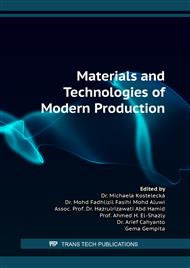p.3
p.11
p.21
p.29
p.39
p.45
p.59
p.71
Assessing the Potential of Upcycling Waste Plastics into Mechanically Strong Water-Resistant Thermal Insulation Carbon Foam via Chemical Blowing Method and Low Temperature Carbonization
Abstract:
This work presents the recyclability of waste plastics into mechanically strong water-resistant carbon foam by chemical blowing method and low-temperature carbonization. Waste polystyrene (PS) was used as a precursor. The synthetic carbon foam (CF) was characterized using scanning electron microscope (SEM), transmission electron microscope (TEM), energy dispersion X-ray spectroscopy (EDX), C-H-N-S elemental analyzer, X-ray diffraction (XRD), Fourier transform infrared spectroscopy (FTIR), thermal constants analyzer and universal compression tester. The synthesized carbon foam exhibits a low density (0.32 g/cm3), low thermal conductivity (0.074 W/m.K), high compressive strength (58 MPa) and high strength/density ratio (181 MPa/g/cm3). The synthesized carbon foam is a potential candidate for thermal insulation in energy-saving buildings and the technology is a simple, cheap, and sustainable approach to managing waste plastics.
Info:
Periodical:
Pages:
21-26
Citation:
Online since:
September 2022
Authors:
Price:
Сopyright:
© 2022 Trans Tech Publications Ltd. All Rights Reserved
Share:
Citation:


